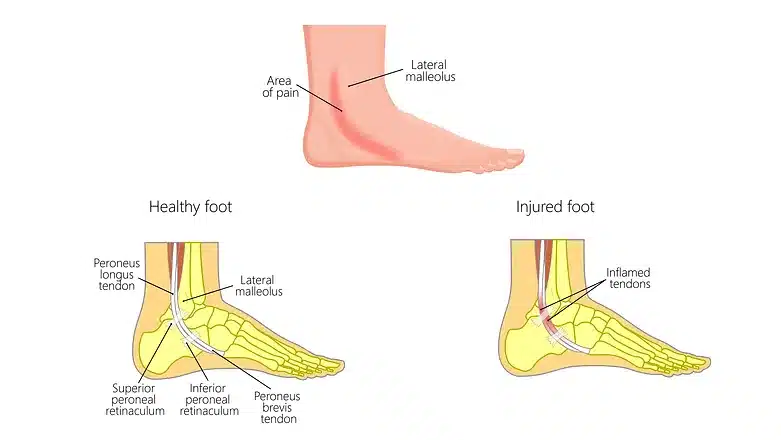Peroneal Tendinopathy

Peroneal tendonitis occurs when the peroneal tendons become inflamed. This happens when there is an increased load and overuse of the tendons, leading to them rubbing on the bone.
This friction causes the tendons to swell. Over time, the tendons will thicken in size to try and manage the increased load more efficiently.
Peroneal tendonitis is particularly common in athletes and especially runners, as they are more likely to make their feet roll outwards, causing friction between the tendon and bone.
There are two peroneal tendons in each leg. They run side by side down the lower leg bone (fibula) and behind the bony lump on the outside of the ankle called the lateral malleolus.
One peroneal tendon attaches to the outside of the foot at the base of the little toe (fifth metatarsal). The other tendon goes underneath the foot and attaches to the inside of the arch.
The peroneal tendons provide stability to the ankle when it is bearing weight and protects it from sprains. They also help turn the foot out and stabilize the arch when walking.
PERONEAL TENDON ANATOMY

DISEASE EXPLAINED

SYMPTOMS
Peroneal tendonitis can either be acute, meaning that it comes on suddenly; or it can be chronic, meaning that it develops over time.
In both cases, there are some common symptoms:
Pain at the back of the ankle
Pain that worsens during activity and lessens during rest
Pain when turning the foot in or out
Swelling at the back of the ankle
Instability of the ankle when bearing weight
The area is warm to the touch
CAUSES
People who take part in a sport that involves repetitive ankle motion are most prone to peroneal tendonitis.
Factors that can contribute to peroneal tendonitis include:
Overuse
A sudden increase in training, particularly weight-bearing activities, such as walking, running, and jumping
Improper training techniques
Inadequate or unsupportive footwear
There are also some other issues that can increase a person’s risk of developing peroneal tendonitis:
Higher foot arches
Lower limb muscles and joints not working well together
Imbalanced muscles in the lower limbs
If someone fails to complete a rehabilitation program following an ankle injury, such as a sprain, they are also more likely to develop peroneal tendonitis.
Over time, the damaged peroneal tendons will thicken as scar tissue tries to repair the damaged area. This makes the tendons weaker and more prone to tearing.
TREATMENT

TREATMENT OPTIONS
Because overuse of the tendons often causes peroneal tendonitis, rest is crucial to help them heal.
The individual should avoid walking or any other activities that may aggravate the injury until the pain has gone. The area needs time to recover and, in time, the pain will lessen.
Nonsurgical treatments that are common in cases of peroneal tendonitis include:
IMMOBILIZATION
Stopping the foot and ankle from moving using a boot or support.
MEDICATION
Anti-inflammatory drugs, such as ibuprofen, can help relieve pain and swelling.
PHYSICAL THERAPY
Ice, heat, and ultrasound therapy can reduce pain and swelling. Once the symptoms improve, introduce exercises that strengthen the muscles and improve balance and motion.
BRACING
Some people may require a brace for use during activities that involve repetitive ankle motion.
CORTISONE INJECTION
In rare cases, doctors may recommend this powerful anti-inflammatory medication. However, if cortisone is injected into the peroneal tendons, there is a chance of rupture.
Surgery is rare when treating peroneal tendonitis, and it is only usually considered as a last resort if nonsurgical methods are not helping to reduce pain.
If tissue around the tendons is causing irritation, the surgeon may undertake a procedure called tendon release to remove it.
If a tear has occurred because of overuse of the peroneal tendons, the surgeon will also look to perform tendon repair.
DISCLAIMER
- All of the opinions expressed within the educational information delivered within the provided links are those of their authors and not necessarily those of either your treating doctor or CRO.
- This site is for educational purposes only!!
- Copyright Disclaimer under Section 107 of the copyright act 1976, allowance is made for fair use for purposes such as criticism, comment, news reporting, scholarship, and research. Fair use is a use permitted by copyright statutes that might otherwise be infringing. Non-profit, educational, or personal use tips the balance in favor of fair use.
